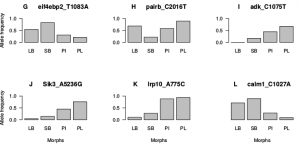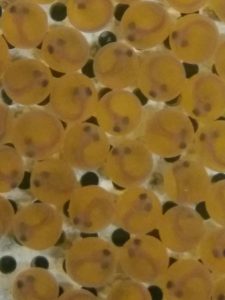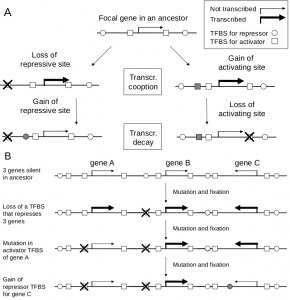Útdauði dýra er raunverulegt vandamál og hann getur haft alvarlegar afleiðingar.
Ástæður útdauða eru margvíslegar, ofveiðar, eyðing búsvæða, landnýting, mengun frá t.d. landbúnaði og iðnaði, og vitanlega loftslagsbreytingar.
Í fyrri viku bárust tíðindi af því að fyrsta spendýrið hafi dáið út augljóslega af völdum loftslagsbreytinga.
Tegund sem kallaðist Bramble Cay melomys, var mús sem bjó á lítilli Ástralskri eyju. Hún lifði á litlu rifi milli Ástralíu og Papúa nýju gíneu.
Hækkandi sjávarstaða vegna loftslagbreytinga eyddi búsvæðum á eyjunni. Vitað var um afdrif hennar, vegna þess að hún hafði verið rannsökuð og bjó á lítilli eyju (og vegna þess að hún var sæt mús). Fyrir hverja eina slíka tegund sem við missum, er hætt við að við missum tugi, hundruði, þúsundir annara, ekki jafn vel þekktra eða minna heillandi, vegna loftslagsbreytinga.
Endurfundur skjaldbökunnar
Á svipuðum tíma bárust fréttir af því að skjaldbaka sem talin var útdauð fannst aftur. Skjaldbakan Chelonoidis phantasticus (Kelenædis fantastíkus með íslenskri latínu), býr á Fernandina eyjunni í Galápagoseyjaklasanum. Síðast sást til tegundarinnar fyrir 110 árum, og talið var að hún væri útdauð í kjölfar eldgos. En náttúrufræðingar höfðu fundið margvíslegar vísbendingar um tilvist skjaldböku á eyjunni, m.a. grunsamlegan saur. Með samstilltu stórátaki fannst ein skjaldbaka tegundarinnar. Ljóst er að þó eitt eintak hafi fundist og tegundin ekki formlega útdauð, eru ekki margir einstaklingar eftir.
Blessunarlega eru ennþá óspillt svæði á jörðinni, m.a. á Galapagos eyjum, með stóra þjóðgarða þar sem dýr og aðrar lífverur hafa athvarf. Þau athvörf eru samt of fá, lítil og fer fækkandi.
Hrun skordýra
Nokkrar nýlegar rannsóknir hafa afhjúpað hnignun stofna skordýra. Rannsóknir á skordýrum eru mun erfiðari en á stærri dýrum og gögnin sem fyrir liggja gloppóttari. Samt er augljóst að stofnar skordýra hafa látið á sjá, eins og þekkist e.t.v. best á ástandi býflugnastofna í Evrópu og norður Ameríku. Fréttir um skordýrahrunið voru kannski aðeins of dramatískar, en þær vörpuðu a.m.k. ljósi á vanræktan risa. Skordýr eru ákaflega mikilvæg, í vistkerfum og fyrir landbúnað, en veruleikinn er sá að við þekkjum þau fáranlega illa. Skordýr tilheyra liðdýrum, sem eru 80% af öllum þekktum tegundum dýra. Til að mynda hefur um 900.000 skordýrategundum verið lýst. Talið er að heildarfjöldi tegunda skordýra sé eitthvað í kringum 30 milljónir. Til samanburðar eru bara þekktar um 6500 spendyrategundir. Ólíklegt er að margar tegundir spendýra séu ófundnar.
Spurt var, getur erfðafræðin hjálpað okkur við að bjarga tegundum frá útdauða?
Þrennt hefur verið nefnt. Notkun erfðagreiningar til að skilja fjölbreytileika tegunda og stofna, notun erfðaupplýsinga til að stýra æxlunum tegunda í útrýmingarhættu (til að forðast innæxlun eins og í dýragörðum), eða nota sameindaerfðafræði og frumulíffræði til að klóna tegundir eða erfðabreyta núlifandi tegundum þannig að þær líkist útdauðum (t.d. fíl í loðfíl).
Fyrri nálganirnar tvær er auðveldar í framkvæmd og mikið notaðar, hin síðastnefnda er nær því að vera vísindaskáldskapur en veruleiki. Erfðatæknin mun ekki gagnast, þrátt fyrir yfirlýsingar sumra vísindamanna, til að bjarga tegundum frá í útrýmingarhættu. Sannarlega hafa nokkrar tegundir verið klónaðar, svo sem kindur, kýr og skyldar tegundir, en einnig nokkrar aðrar. Heilmikið og kostnaðarsamt þróunarstarf er nauðsynlegt til að geta klónað einstaklinga ákveðinnar tegundar. Þannig að fyrir hverja eina tegund sem við myndum vilja klóna og bjarga á þann hátt yrðum við að leggja í mikinn startkostnað. Og alls er óvíst að klónunin heppnis. Ekki hefur tekist að klóna öll dýr sem reynt hefur verið. Dollý var t.d. afurð tilraunar 277, með klónun á kindum.
Ekki er verjandi að eyða meiri fjármunum í að búa til einn klónaðan nashyrning - en þyrfti til að halda uppi og vernda mörgþúsund ferkílómetra þjóðgarði í langan tíma.
Mikilvægust eru orsakir þess að dýr og aðrar lífverur eru í útrýmingarhættu, þ.e. gjörðir mannana. Eyðing búsvæða vegur þar mest. Ef við klónum fullt af dýrum, en setjum þau síðan í agnarsmáa þjóðgarða eða læsum inni í dýragarði, þá höfum við ekki bjargað málunum. Við höfum í besta falli afvegaleitt sjálf okkur, og frestað því að takast á við rót vandans.
Okkar mesti galli - blinda á hægar breytingar
Við manneskjurnar erum léleg í því að mæla hægfara breytingar, á náttúrunni og öðrum hlutum. Enska hugtakið sem lýsir þessum galla okkar er Shifting baseline syndrome, sem þýða mætti sem viðmiðið hreyfist heilkennið.
Frægt dæmi er af sportveiðum. Hvert einasta ár er haldin sportveiði, og einhver fiskur er stærstur og fólki finnst hann risatór. En ef bornir eru saman stærstu fiskana yfir langt tímabil, t.d. frá 1910 til 2010, sést að þeir fara sífellt minnkandi. Fólk skynjar þetta ekki, því viðmiðið færist á hverju ári.
Það sama á við um allt mat okkar á ástandi náttúrunnar (og mögulega þáttum í samfélaginu). Í Evrópu og Ameríku hefur skordýrum fækkað vegna eyðingu búsvæða, ræktarland kemur í stað villtrar náttúru, og húsahverfi í stað akra, með þeim afleiðingum að yfir ár og áratugi fækkar skordýrunum.
Þetta birtist um alla jörð, í mörgum þáttum umhverfis, og orsakirnar eru yfirleitt mennskar. Breytingar eru á loftslagi, vegna þess að við keyrum bíla, kaupum drasl og fljúgum til útlanda oft á ári! Ef við viljum bjarga sjálfum okkur, börnum okkar og lífinu á jörðinni í leiðinni, þá þurfum við að breyta hegðan okkar. Og þrýsta á stjórnvöld að taka til aðgerða. Við eigum ekki að mótmæla þegar grænir skattar eru settir á eldsneyti til að auðveld orkuskipt, eða flugfargjöld hækka til að draga úr loftslagsbreytingum! Hugsa um langtímahag ekki skammtímavellíðan.
Pistillinn var ritaður eftir samræður við Morgunútvarpsfólk á Rás 2 þann 22. febrúar 2019 (Útrýmingarhætta) og birtist fyrst á apalsson.blog.is (Útdauði tegunda og blinda okkar á hægar breytingar)
Ítarefni:
. CNN 21. febrúar 2019. Australian mammal becomes first to go extinct due to climate change. https://edition.cnn.com/2019/02/20/australia/mammal-climate-change-extinction-intl-trnd/index.html
Giant tortoise believed extinct for 100 years found in Galápagos – The guardian 21. feb 2019.
Ed Young 19. feb. 2019. The atlantic Is the Insect Apocalypse Really Upon Us?
By Brooke Jarvis, 27. nóv. 2018 The Insect Apocalypse Is Here.



